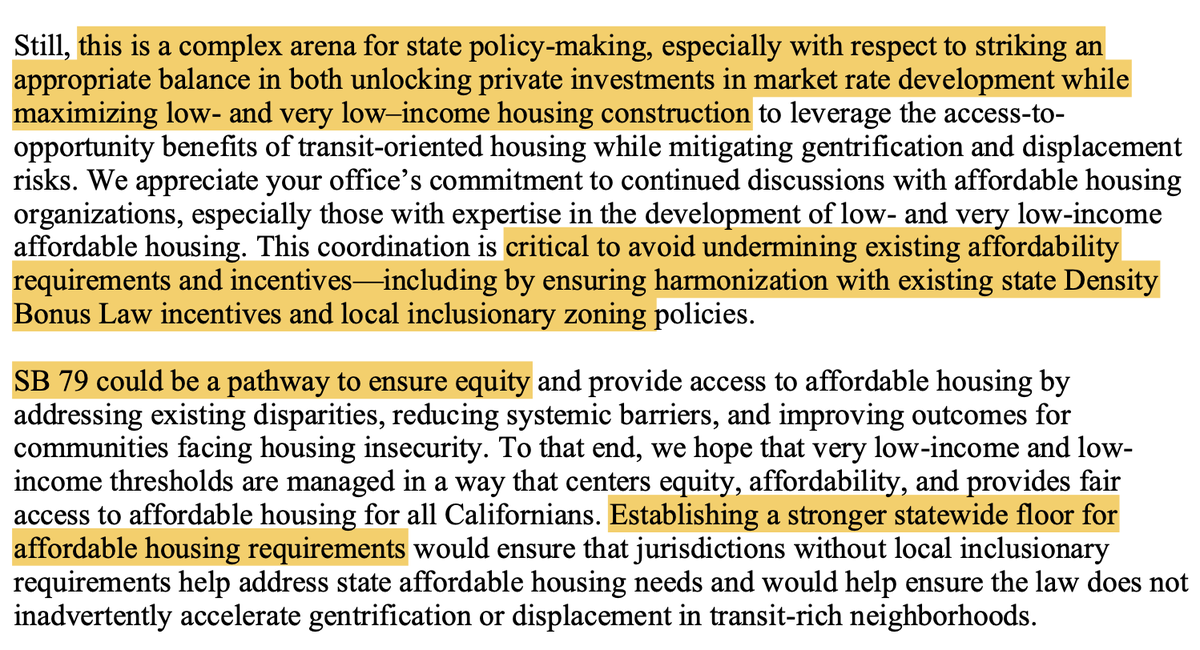For years, California environmentalists have been MIA or worse on an absolute no-brainer of green policy: building dense housing near transit.
Are changes afoot? ⤵️
Maybe! But @NRDC's SB 79 support letter also shows persistence of addled Groups-blob thinking.
🧵/14.
Are changes afoot? ⤵️
Maybe! But @NRDC's SB 79 support letter also shows persistence of addled Groups-blob thinking.
🧵/14.
https://twitter.com/cayimby/status/1937979751177822551
First, some context:
- How I came to be an environmentalist without a home in the environmental movement,
/2
- How I came to be an environmentalist without a home in the environmental movement,
/2
https://x.com/CSElmendorf/status/1558261164378767362
- How CA enviros were duped or white-guilted into letting greenfield developers get their dream policy enacted, even as the same orgs continued to fight infill housing,
/3motherjones.com/environment/20…
/3motherjones.com/environment/20…
A @Scott_Wiener bill now pending in the legislature, SB 79, would upzone land within 1/2 mile of fixed transit for 65'-75' apartment & condo buildings, regardless of underlying zoning.
/4
/4
As introduced, the bill was distinctive for its plain-bagel character.
It did not require projects to provide money-losing affordable housing, or to use high-cost labor, as a precondition of approval.
/5
It did not require projects to provide money-losing affordable housing, or to use high-cost labor, as a precondition of approval.
/5
https://x.com/CSElmendorf/status/1899336444013138206
But, w/o enviro support, it was a slog to get SB 79 through the legislative committees.
The bill initially stalled out at Senate Appropriations. Then it was rescued by the addition of an affordability mandate patterned on the state's Density Bonus Law.
/6

The bill initially stalled out at Senate Appropriations. Then it was rescued by the addition of an affordability mandate patterned on the state's Density Bonus Law.
/6


Now lets dig into @NRDC's new SB 79 support letter.
It opens w/ a perfunctory recitation of enviro benefits of dense infill development near transit (less VMT/GHG, less sprawl into environmentally sensitive lands).
/7
It opens w/ a perfunctory recitation of enviro benefits of dense infill development near transit (less VMT/GHG, less sprawl into environmentally sensitive lands).
/7

This is followed by two paragraphs of hand-wringing about the "complex[ities]" of "striking an appropriate balance" b/t market-rate and low-income development via BMR mandates. Oof.
/8
/8

NRDC expressly conditions its support on SB 79's 11th-hour IZ mandate.
Going further, NRDC calls for a "stronger statewide floor for affordable housing requirements." Oof.
/9
Going further, NRDC calls for a "stronger statewide floor for affordable housing requirements." Oof.
/9
Nowhere does @NRDC acknowledge that California's imposition of an unfunded IZ mandate on housing near transit will mean less housing near transit in CA--and more sprawl in California and other states. Oof.
/10
ternercenter.berkeley.edu/wp-content/upl…
huduser.gov/portal/periodi…
/10
ternercenter.berkeley.edu/wp-content/upl…
huduser.gov/portal/periodi…
Though it does not outright endorse what @drvolts recently called the "craziest" position he'd ever heard--that dense housing near fixed transit is good only if it's deed-restricted for affordability--the letter certainly gestures in that direction.
/11
/11
https://x.com/CSElmendorf/status/1937959277194260873
It exhorts the bill's author to "continue discussions with affordable housing organizations."
This seems like a roundabout way of signaling that NRDC may withdraw its support if the author can't get some backing from the it's-only-good-if-its-deed-restricted camp.
/12
This seems like a roundabout way of signaling that NRDC may withdraw its support if the author can't get some backing from the it's-only-good-if-its-deed-restricted camp.
/12
One wonders whether NRDC's leadership actually wants dense transit-oriented development to occur, or whether they're just looking to bridge internal conflicts and avoid being called out by the likes of @ezraklein.
/13
/13
I want to believe that a "green transition" is underway within NRDC and other major green groups, but I don't see much evidence for it yet.
/end
/end
@threadreaderapp unroll
• • •
Missing some Tweet in this thread? You can try to
force a refresh
















